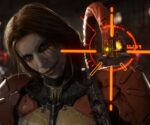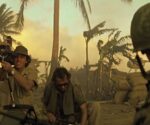Death Stranding 2 review: Kojima has failed – he’s delivered a PS5 must-play | Gaming | Entertainment
Note: This is a review-in-progress as, make no mistake, Death Stranding 2 is a huge game and we’re still wrapping up the end of the story missions. Tested on PS5 Pro. We’ll update this in future.
Hideo Kojima has failed with Death Stranding 2. The legendary creator of Metal Gear Solid recently went on record to note that he had made several changes to this game, the follow-up to the ambitious yet divisive first entry, in a bid to make it less enjoyable because – and I quote – playtesters thought it was ‘too good’.
We might never know what he changed, but it hasn’t worked. Because Death Stranding 2 on PS5 might well be his magnum opus.
Death Stranding 2 defies genre, but the best way to sum it up is that it’s a courier game meets resource management sim meets open world sandbox, with an emotive – if at times indulgently sci-fi-silly – story driving the action between deliveries. Much like the first game, Death Stranding 2 follows a ‘porter’ named Sam, who’s tasked with reconnecting a huge communications network in a post-apocalyptic world. Where the first game was set in North America, DS2 expands its scope, kicking off firstly in the mountainous deserts of Mexico in its first few chapters before expanding to the entirety of Australia.
The premise is simple, even if the story isn’t – as Sam, you need to take on various deliveries, moving precious cargo from point to point, which can be done on foot or in vehicles. For each mission, you need to check the map, assess the best route, and then plan the resources you’ll take. Planning is crucial – fail to pack the right guns and you could come a-cropper on a big battle. Fail to bring the right supplies and you might run out of stamina or health halfway up a mountain. But over-pack, and you could also run out of steam or smash all your cargo in a horrid accident.
Although the game gives you lots of pointers about how to approach any given scenario, it’s totally up to you.
Each item you bring adds weight to your cargo, and you need to think hard about whether each item is worth slowing you down. The more weight you carry, the better prepared you are, but the slower you move, and the easier it is to fall down and lose precious supplies. Every step you take has a management element – you can even use the triggers to balance your weight as you walk.
Tasked with taking heavy items to a base filled with enemies, there’s myriad approaches available. Do you pack light, to better avoid detection, and then sneak through the base, throwing decoy grenades (new to DS2) and bind enemies with stealth? How do you keep the cargo safe – keep it with you and try to avoid damage, put it in a car, or stash it in a hiding place to return to later? Do you pack a load of guns, and go in blazing for a COD-style shootout? Or do you drive into the base, with gun loaded onto your vehicle, take out the first wave from the driver’s seat and then retreat into stealth and pick off the rest using decoys and binding rope? It’s entirely up to you, and before long the internet is going to be filled with various videos of players finding more and more creative solutions to each mission. This includes various structures you can build from your ‘Q-Pid’ device – from bridges to shelters, generators to charge batteries and more.
Weaved through all of this is the online element. Whenever you’re in an area with ‘network coverage’, you’ll find structures built by other players. Maybe a porter left a bridge over a river, or put up a timefall shelter in a great spot. At the same time, if you leave a useful vehicle hidden behind a cliff, another player can find and use it. It means the world never feels lonely, and even in this single-player epic, you can find and help others overcome challenges collectively, as part of a greater whole.
The main improvement in DS2 over the original is a much improved combat system, which means fighting is a genuine option rather than a last resort. There’s more guns, and enemy camps dot the landscape, inviting you to go in and fight rather than always be sneaking. Fighting is quicker (though how agile you can be depends how much you’re carrying), there’s a bigger arsenal of weaponry, and more flexibility with additions like decoy grenades. If your trigger finger is quick enough, you could play much of the game in a guns-blazing style.
You will probably avoid combat sometimes, though. While human enemies and ‘ghost mechs’ in bases can be straight-up dogfights, the returning BTs are more unpredictable.
BTs are ghostly apparitions that stalk various parts of the map. They add an element of real danger to many deliveries. Simply entering an area with BTs roaming will trigger a warning, with your radar then constantly scanning to alert you when one is nearby. Often, I found myself treading extremely carefully, and attempting to slip undetected through these BT minefields. Other times, I failed, and was dragged into a fight with some vicious spirit creatures. One mistake can quickly see your cargo smashed and Sam dragged into the depths of ‘the beach’ and forced to reload.
Phrases like BTs, the beach, the tar, the DHV Magellan abound, and yes, this is a game unapologetically rich in made-uppy science. You’re trying to connect up a network to protect this post-apocalyptic world from ghostly creatures that can drag victims to the afterlife, and the game does not shy away from sci-fi silliness like a talking puppet possessed by a spirit as your main sidekick and guide, or a mannequin head with a moving hologram face as a key character.
But below its eccentric idiosyncrasies, and its creator’s attempt to eschew the mainstream by being a bit self-indulgent, the emotive core of this story is one of parental responsibility. Sam is doing all this for Lou, the baby he rescued in the first game. No spoilers, but what happens to Lou (or BB-28), how, and why, and Sam’s struggle to protect her and his search for answers, forms the emotional core that drives you on, propped up by a stellar cast including the returning Lea Seydoux as Fragile. Ultimately, deep underneath all the made up stuff, Sam’s accidental fatherhood, and how he grows into the role of doting dad, is the heart on this game’s tech-infused sleeve, and puts it up there with other recent PlayStation exclusives like The Last Of Us and God of War for emotional clout. But in between the heartfelt moments, it’s not afraid to be a game. Weird, gameplay-led, strategic, offbeat, and sometimes downright bizarre.
It’s a technical tour de force, too. In a generation dogged by complaints of diminishing returns, Death Stranding 2 could not have been a PS4 game. Its world is humungous and the terrain is so interesting just to traverse. Huge, fast flowing rivers cut through canyons of mountains, lush jungles border vast deserts, while complex bases full of tunnels, abandoned buildings and decaying roads punctuate mountain ranges with blizzards and snowstorms. Just crossing any part of it is a minefield of thick boulders, steep slopes and constant decision making: do I cross over this peak, or go round it? Will my resources get me over this field, or should I build a bridge over this river? On PS5 Pro, Quality Mode runs at 60fps and Performance at 120fps, though with VRR on, so the underlying frame rate might be lower. Both look phenomenal, a simply staggering visual clarity with sometimes so much happening on screen, tremendous physics, truly next-gen animations and a sense of scale that’s unmatched.
It’s not going to be for everyone. It revels in its strangeness, and requires dedication and concentration, both on its missions and its somewhat convoluted story. But despite Mr Kojima’s protestations, this is a game that rounds off the rough edges from the first trip out and delivers a more well rounded, more balanced and more interesting second outing and is easier to reccommend either to returning players or first time porters (a recap of the first game is available).
In all, Death Stranding 2 is a titanic effort, a massive single player game with easily 100-hours plus to experience, an indulgent, silly, crazy, heartbreaking, heartwarming, human, otherworldly, challenging, relaxing, mass of contradictions, a huge improvement over the original and a PS5 must-play. And we’re not even finished yet…








